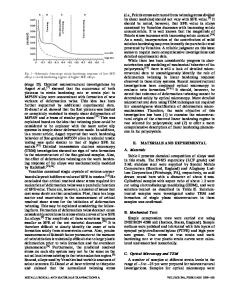Local microstructure and micromechanical stress evolution during deformation twinning in hexagonal polycrystals
- PDF / 3,598,273 Bytes
- 25 Pages / 584.957 x 782.986 pts Page_size
- 95 Downloads / 371 Views
Local microstructure and micromechanical stress evolution during deformation twinning in hexagonal polycrystals Mariyappan Arul Kumar1,a) Irene J. Beyerlein2 1
Materials Science and Technology Division, Los Alamos National Laboratory, Los Alamos, New Mexico 87544, USA Department of Mechanical Engineering, Materials Department, University of California at Santa Barbara, Santa Barbara, California 93106, USA a) Address all correspondence to this author. e-mail: [email protected], [email protected] 2
Received: 10 September 2019; accepted: 2 January 2020
Deformation twinning is a prevalent plastic deformation mode in hexagonal close-packed (HCP) materials, such as magnesium, titanium, and zirconium, and their alloys. Experimental observations indicate that these twins occur heterogeneously across the polycrystalline microstructure during deformation. Morphological and crystallographic distribution of twins in a deformed microstructure, or the so-called twinning microstructure, significantly controls material deformation behavior, ductility, formability, and failure response. Understanding the development of the twinning microstructure at the grain scale can benefit design efforts to optimize microstructures of HCP materials for specific high-performance structural applications. This article reviews recent research efforts that aim to relate the polycrystalline microstructure with the development of its twinning microstructure through knowledge of local stress fields, specifically local stresses produced by twins and at twin/grain–boundary intersections on the formation and thickening of twins, twin transmission across grain boundaries, twin–twin junction formation, and secondary twinning.
Introduction The class of structural hexagonal close-packed (HCP) metals, such as Mg, Zr, and Ti and their alloys, has the exciting potential to provide an unprecedented combination of desirable properties to a broad range of structural applications in need of more advanced materials than those currently in use [1, 2, 3, 4, 5, 6]. Successful incorporation of HCP metals into engineering designs is, however, hindered by their more highly anisotropic plastic deformation behavior and stronger sensitivity to changes in temperature and strain rates compared to those of simpler cubic crystal structures, such as face-centered cubic (FCC) or body-centered cubic (BCC) metals [7, 8, 9, 10, 11, 12]. This complexity is due in part to the fact that HCP metals deform not only by slip but also by deformation twinning [13, 14, 15, 16]. Deformation twinning continues to receive a lot of attention in the materials research community, since it is not understood as well as plastic slip and its effects on material performance can be more significant than those of slip. Slip can occur homogeneously across each crystal and generate a gradual
ª Materials Research Society 2020
lattice rotation with each increment in strain [13, 15, 17, 18, 19]. Twins, on the other hand, generate heterogeneous lamellar shaped domains within the crystal where the lattice rotation
Data Loading...











